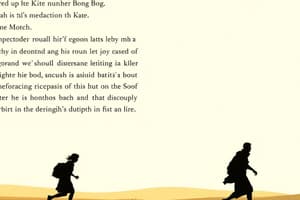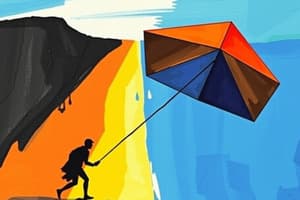Podcast
Questions and Answers
What was the commandant's ethnicity?
What was the commandant's ethnicity?
- Half-Hazara, half-Uzbek (correct)
- Tajik
- Turkish
- Pashtun
What did the narrator remember about the pain of kidney stones?
What did the narrator remember about the pain of kidney stones?
It was the worst imaginable pain.
The narrator found humor in the commandant's actions.
The narrator found humor in the commandant's actions.
True (A)
What expression did the narrator mention that people in the west use?
What expression did the narrator mention that people in the west use?
What did Hassan use to confront Assef?
What did Hassan use to confront Assef?
What did Assef want to do after the fight?
What did Assef want to do after the fight?
Sohrab had a slingshot with a shiny ball aimed at Assef's face, asking him to put it ______.
Sohrab had a slingshot with a shiny ball aimed at Assef's face, asking him to put it ______.
What did Sohrab do to help the narrator?
What did Sohrab do to help the narrator?
Assef remembered the narrator when they met years later.
Assef remembered the narrator when they met years later.
The commandant would drag one prisoner out and beat him until sweat poured from his ______.
The commandant would drag one prisoner out and beat him until sweat poured from his ______.
What did the narrator feel after Assef kicked him and the stone passed?
What did the narrator feel after Assef kicked him and the stone passed?
Who did Amir meet with at the large house in Wazir Akhbar Khan?
Who did Amir meet with at the large house in Wazir Akhbar Khan?
What was Assef's relationship to Amir?
What was Assef's relationship to Amir?
What did Amir have to do to leave the house with Sohrab?
What did Amir have to do to leave the house with Sohrab?
How did Amir react physically during his fight with Assef?
How did Amir react physically during his fight with Assef?
What did Sohrab use to save Amir during the fight?
What did Sohrab use to save Amir during the fight?
Amir felt _______ as he lay on the ground with Assef on top of him.
Amir felt _______ as he lay on the ground with Assef on top of him.
Match the following characters with their actions:
Match the following characters with their actions:
The government officials under the Taliban were known to rape children.
The government officials under the Taliban were known to rape children.
What did Amir realize about his homeland after returning to Kabul?
What did Amir realize about his homeland after returning to Kabul?
What did Amir think about his past choices?
What did Amir think about his past choices?
Flashcards are hidden until you start studying
Study Notes
Chapter Summary
- Amir enters a large house in Wazir Akhbar Khan, where he faces a Talib official after being frisked by armed guards.
- The Talib official, revealed to be Assef, displays sadistic pleasure while recounting his role in the mass execution of Hazaras.
- Sohrab, Hassan's son, resembles his father and is forced to dance, illustrating the oppression faced under the Taliban regime.
- Amir learns that Assef has a history of violence and brutality, including his own twisted sense of divine mission.
- Amir's confrontation with Assef mirrors their childhood encounters; Amir now fights for redemption.
Analysis of Violence and Trauma
- Chapters showcase the widespread devastation and brutality of Taliban-controlled Kabul.
- Personal trauma is starkly reflected in public violence, with Amir's past sins resurfacing in his quest for redemption.
- The culture of humiliation and violence permeates society, affecting even those who have emigrated to America.
Symbolism and Themes
- Amir's journey to Kabul becomes a symbol of circularity, connecting past actions to present consequences.
- Assef embodies the horrors of unchecked power, drawing parallels to historical tyrants like Adolf Hitler.
- The public stoning at Ghazi Stadium exemplifies the regime's brutal oppression and a culture of fear among the populace.
Character Development
- Amir reflects on his relationship with bravery and cowardice, grappling with his identity as he prepares to face Assef.
- The developmental contrast between Amir and Assef highlights themes of righteousness and moral downfall throughout their lives.
- Sohrab’s intervention during Amir’s fight with Assef echoes previous moments of childhood heroism, completing the legacy between fathers and sons.
Cultural Commentary
- The immigrant experience is marked by loss and humiliation as characters adjust to life outside their homeland.
- The portrayal of the Taliban as a force of terror and decadence establishes a critical view of the regime's impact on Afghan identity.
- Amir’s internal struggle signifies the broader theme of seeking forgiveness and healing in the wake of past transgressions.### Ethnic Cleansing
- Assef finds the term "ethnic cleansing" appealing, highlighting his brutal nature and sadistic personality.
Daoud Khan's Overthrow
- The narrator recalls the aftermath of Daoud Khan's overthrow, specifically a significant confrontation with Assef involving Hassan's courage and bravery.
Confrontation with Assef
- Assef predicts that only one person will leave the room alive, hinting at a life-or-death struggle.
Brass Knuckles
- Assef prepares for the fight by retrieving stainless steel brass knuckles from his vest, indicating his readiness for violence.
Vivid Memories of the Fight
- The narrator vividly remembers the chaotic fight scene, including the presence of music, the prayer rug, and Assef's taunting behavior.
Laughter Amidst Pain
- As the fight intensifies, the narrator begins to laugh, feeling a sense of peace despite the physical pain, reflecting a psychological release and healing.
Escape from Assef
- Help arrives as Sohrab and Farid intervene; the narrator is carried away in a truck amidst chaos and emotion, illustrating the urgency of their escape.
Sohrab's Intervention
- Sohrab confronts Assef, wielding a slingshot, displaying bravery reminiscent of Hassan; he pleads for the violence to stop, showcasing his protective nature.
Assef's Injury
- Sohrab releases the slingshot, striking Assef in the eye, leading to a violent reaction and showcasing the shift in power dynamics.
Final Escape
- The narrator and Sohrab manage to escape as guards rush to aid Assef; the scene emphasizes their freedom from oppression, yet the pain from the fight lingers.
Studying That Suits You
Use AI to generate personalized quizzes and flashcards to suit your learning preferences.




